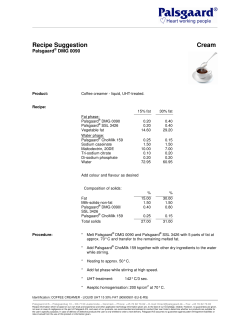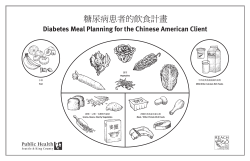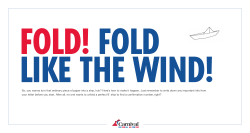
Research on the use of Ultrasound Cavitation INTRODUCTION
Research on the use of Ultrasound Cavitation (35 – 40 KHz) in the treatment of Localized Fat. Research writers: V. Rapallini1, D. Torletti2 and D. Ceballo.3 Abstract: The efficacy of 35-40 KHz Ultrasound for the Localized Fat treatment. The Fat fold diminished in the treated areas. The use of Lymphatic drainage techniques after the Cavitation application improves the results. Key words: 35-40 Khz Ultrasound, Cavitation, Localized Fat. INTRODUCTION ULTRASONIDOS Ultrasonic cavitation has recovered its leading role due to effects achieved through its application at emission frequencies significantly higher than the frequencies currently used in the Field of Aesthetic Medicine. The cavitation phenomenon takes place when a fluid medium, in this case, a biological one, is reached by the ultrasonic wave. Such wave consists in compression-expansion cycles produced at high speed that is directly related to the workflow of the equipment ultrasonic generator. Compression phases exert positive pressure on the fluid whereas expansion phases exert negative pressure. During compression phases, the fluid molecules tend to move closer; contrariwise, they tend to move away during expansion phases. As said phases repeat, micro-bubbles show a progressive enlargement that causes their collapse and implosion producing shockwaves’ emission. The high pressure exerted by compression phases on expanded cavities causes micro-bubbles’ collapse. This process is named Cavitation Phenomenon. Emulsificated fluid content is carried through vascular and lymphatic tracts to the liver. Once it is in the liver, it follows the organism’s normal mechanisms. 1- Previo al comienzo del tratamiento. Estructura básica del tejido graso. 2- Durante el tratamiento. Pasados 5 minutos. 3- Se observa la liquefacción de las células grasas básicas. 4- Grasa licuada por rotura de las membranas en células grasas y microvasos no dañados por el efecto de la cavitación. CAVITATION PHYSIOLOGICAL EFFECTS Cavitation of fat tissues is selectively produced by the (35-40 KHz) emission frequency since the fluid content of said tissues shows better mobilization at this emission frequency than at current frequencies. Furthermore, higher penetration of the ultrasonic wave, higher compression and lower thermal effect are observed. Most important physiological effects are: Cavitation effect on fat tissues causes fat fragmentation and the subsequent diffusion of the lipid matrix that later joins to the intersectial fluids. Emulsification of the lipid content favours its metabolic assimilation. www.starbene.com - business@starbene.com - +54 351 424-0051 IMAGE 1. Fat tissues` reaction to ultrasonic emission. MATERIAL AND METHOD ADVERSE REACTIONS The research was performed on 20 patients whose age was from 25 to 45 years old presenting different disorders, such as Localized Fat, Overweight and Associated Cellulite. 15 sessions of 35 – 40 KHz ultrasound were performed. Immediately after the session was performed, little inflammatory vesicles, similar to a folliculitis, were observed. Two different types of vesicles were observed, one of generalized manifestation, other of small, well defined areas. This reaction did not appear in all patients. Adverse reactions disappear approximately one hour after finishing the session. To carry out the research, it was used the Starbene Cavistar equipment which main characteristics are: An ultrasound generator, made up of an AC generator that feeds an emitting handpiece where an inserted transducer (quartz or ceramics) converts electric energy into mechanical energy (acoustic vibrations). The highest operation power is 3Watts/cm2. Two types of ultrasonic emission: Continuous emission, with power regulation system, and pulsating emission, with pulse frequency regulation system, Duty Cycle and Power. Duration can be adjusted. The equipment software allows the Professional to modify all emission parameters. After the session, Vacum-Dermo-Mobilization was applied on the treated area during 20 minutes so as to favour lymphatic drainage. The session protocol was performed under the following methods: 1.Patient’s anamnesis where general information about the patient is also recorded. (*). It includes photographic record. 2.Measuring of the fold to be treated with a FADA skinfold calliper and of the perimeter to be controlled with a metallic tape and anthropometrical method. 3.Application of neutral gel on the area to be treated. 4.Application of Cavistar (35-40 KHz Ultrasound) during approximately 20 minutes on each area of treatment. 5.Application of Vacum-Dermo-Mobilization during 20 minutes on the whole treated area so as to favour lymphatic drainage. 6.Patients’ suggestions to provide support to the treatment. e. (*) It is requested when clinical records are necessary to confirm the patient’s good health condition. In order to control the patient’s evolution during treatment, it is recommended to perform 4 measurements before the first session and to repeat the record in the last session. For a stricter control, it is possible to repeat measuring in the middle of a treatment lasting approximately 8 -10 sessions. Patients must be in good health to go under this treatment. They must not suffer from liver disorders and/or circulatory disorders in the area to be treated. www.starbene.com - business@starbene.com - +54 351 424-0051 Number of patients Generalized reaction 20 Localized reaction 3 6 TABLE I. Number of patients and type of adverse reaction produced. RESULTS Reduction of thickness of the different treated folds was observed. The application on each area never lasted more than 20 minutes. It is important to determine the fold to be treated through the use of a skinfold calliper and the subsequent control with said measuring instrument. The quantity of millimetres reduced in the folds varied from patient to patient depending on the application technique and the parameters chosen by the Professional. The use of lymphatic drainage techniques has improved results. Changes in perimeters and folds were observed. Likewise, the quality of the patient’s skin in the treated areas was also improved. It is important to mention that no other application techniques rather than the ones described in this research were included. BEFORE AFTER IMAGE 2. Patient A treated with Ultrasonic Cavitation. Reduction of the anterior abdominal fold is observed. Example of patient Anterior abdominal fold before treatment. First Session. Anterior abdominal fold after treatment. Session Number 12. A 26 mm 19mm BIBLIOGRAPHY Behari, J en S, Singh, “Ultrasond propagation In “In vivo” bone”. Ultrasond (1981). Dumoulin, J en G. Geske. De Bischop, Electrotheripie 4a edición Maloine SA Paris. Fukada, E. en I. Yasuda. “Piezoelectric effects in collagen”. Japan J. Appl. Phys, (1964)3, 117-121. Haar, ter G., “Basic physics of terhapeutic ultrasond” Physioterapy 64 (1978) 4. * Comparison to diverse surveys published in Internet. WRITERS 1. Dr. V. Rapallini. (Physician. Cosmetologist. Specialist in Aesthetic Medicine). Responsible for Department of Case Studies and Research in Starbene, David Luque 511 (Córdoba, Argentina) capacitación@starbene.com 2. B.S.P.T. Prof. Damián A. Torletti. (B.S. in Physical Therapy and Physical Education Teacher) Responsable for Department of Training, Research and Academic Perfectioning in Starbene. David Luque 511 (Córdoba. Argentina). capacitación@starbene.com 3. B.S.P.T. David Ceballo. (B.S. in Physical Therapy) Department of Training, Research and Academic Perfectioning in Starbene. David Luque 511 (Córdoba. Argentina). capacitación@starbene.com www.starbene.com - business@starbene.com - +54 351 424-0051
© Copyright 2025





















